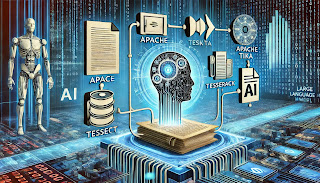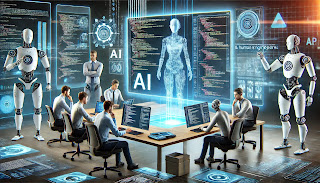The advent of Large Language Models (LLMs) has revolutionized the way machines interact with and process human language. These models, trained on massive datasets, have shown remarkable capabilities in natural language understanding, generation, and translation. However, one persistent challenge remains—parsing and extracting meaningful information from complex documents. Document parsing involves converting unstructured or semi-structured data into a structured format that machines can easily process. As organizations generate and handle an ever-increasing volume of data, efficient and accurate document parsing solutions have become a critical need.
This article explores how open-source tools have risen to address the challenges associated with LLM document parsing, focusing on their accessibility, flexibility, and adaptability for different use cases.
Understanding the Document Parsing Problem
Documents often come in varied formats, such as PDFs, scanned images, Word files, and HTML pages. They may contain a mix of textual data, tables, graphs, images, and other structured elements. Parsing these documents requires the ability to:
- Extract Text: Recognizing and retrieving text from various file formats.
- Detect Structure: Identifying headers, paragraphs, tables, bullet points, and sections.
- Interpret Context: Assigning meaning to the extracted information for downstream tasks such as summarization, classification, or question answering.
While LLMs like GPT-4, BERT, and T5 excel at language understanding, they often require pre-processed and well-structured inputs. Document parsing, especially from formats like PDFs and scanned images, is inherently noisy and complex, making it a significant bottleneck in applications such as automated legal analysis, financial reporting, and academic research.
Why Open Source?
Open-source tools have emerged as the go-to solution for tackling the LLM document parsing challenge due to several factors:
- Transparency: Open-source solutions provide full visibility into the code, allowing users to understand and customize them to suit their specific needs.
- Cost Efficiency: Most open-source tools are free to use, reducing the financial burden of adopting proprietary software.
- Community Support: Open-source projects benefit from large, active developer communities that contribute improvements, bug fixes, and new features.
- Integration Flexibility: These tools can be integrated into various workflows, often with support for programming languages like Python, Java, or JavaScript.
Below, we delve into some of the leading open-source tools that have proven effective for LLM document parsing.
Top Open Source Tools for LLM Document Parsing
1. Apache Tika
Apache Tika is a widely-used open-source library for document parsing and content extraction. It supports a broad range of file formats, including PDFs, Word documents, spreadsheets, and multimedia files.
Key Features:
- Extracts metadata, text, and language information.
- Provides support for Optical Character Recognition (OCR) with tools like Tesseract for parsing scanned documents.
- Offers REST API integration for seamless deployment.
- Written in Java but accessible via bindings for other languages like Python.
Use Case: Tika can be paired with an LLM to process large volumes of multi-format documents, extract relevant information, and feed structured data into the model for advanced NLP tasks.
2. Tesseract OCR
Tesseract is an open-source Optical Character Recognition (OCR) engine developed by Google. It is especially effective for extracting text from images and scanned documents.
Key Features:
- Supports over 100 languages with the ability to train custom models.
- Outputs data in plain text, XML, or other structured formats.
- Integration with Python via the
pytesseractlibrary.
Use Case: Tesseract can be combined with LLMs to process scanned documents like contracts or receipts. For example, after extracting text using Tesseract, an LLM can summarize the content or extract specific data points.
3. PDFplumber
PDFplumber is a Python library specifically designed for parsing PDF documents. It goes beyond simple text extraction by allowing users to analyze the structure of PDF content.
Key Features:
- Extracts text, tables, and embedded images.
- Supports fine-grained control over parsing, such as identifying specific page elements or coordinates.
- Easy integration with data workflows and LLMs.
Use Case: A legal tech startup could use PDFplumber to extract clauses from legal contracts and feed them into an LLM for analysis, classification, or summarization.
4. Haystack
Haystack is an open-source NLP framework by deepset that specializes in building search systems, question-answering pipelines, and information retrieval solutions. It integrates seamlessly with LLMs for parsing and analyzing documents.
Key Features:
- Supports multi-document querying and answering.
- Integrates with various document stores like Elasticsearch, Weaviate, and OpenSearch.
- Provides pre-built components for document processing, including OCR and PDF parsing.
Use Case: Organizations can use Haystack to create a knowledge base by parsing corporate documents and enabling natural language querying via an LLM.
5. GROBID (GeneRation Of BIbliographic Data)
GROBID is an open-source tool that specializes in extracting and structuring bibliographic data and other metadata from scientific and technical documents.
Key Features:
- Extracts titles, authors, affiliations, references, and sections from research papers.
- Supports PDF parsing and conversion to TEI (Text Encoding Initiative) XML format.
- Robust against complex document layouts in academic publishing.
Use Case: Academic researchers can use GROBID to process large datasets of research papers and feed extracted data into LLMs for literature reviews, citation analysis, or summarization.
6. LangChain
LangChain is a framework that simplifies the integration of LLMs into complex workflows, including document parsing. It is particularly suited for building end-to-end applications that combine multiple tools and models.
Key Features:
- Offers components for loading, parsing, and processing documents.
- Provides connectors for tools like Pinecone, Chroma, and Tesseract.
- Enables chaining of tasks, such as parsing, summarization, and querying.
Use Case: LangChain can be used to build a document parsing pipeline that extracts text from PDFs, refines it using LLMs, and stores results in a searchable database.
Advantages of Open Source Tools for Document Parsing
- Customization: Open-source tools can be tailored to specific industries or document types. For instance, a healthcare provider can customize a parser for medical records.
- Cost Reduction: Open-source solutions eliminate licensing costs, making them accessible to startups and research organizations.
- Scalability: Many open-source tools are designed to handle large-scale parsing tasks, suitable for enterprise-level applications.
- Rapid Iteration: With active developer communities, these tools are constantly evolving to include new features and improvements.
Challenges and Limitations
While open-source tools are powerful, they are not without challenges:
- Learning Curve: Implementing and customizing these tools often requires technical expertise.
- Performance Variability: Some tools may struggle with complex or noisy documents, such as scanned PDFs with poor resolution.
- Integration Complexity: Combining multiple tools to build an end-to-end pipeline may require significant effort.
- Resource Intensive: Some tools, like OCR engines, are computationally demanding and may require powerful hardware.
Conclusion
Open-source tools have proven indispensable in solving the LLM document parsing problem. By enabling efficient extraction, structuring, and contextualization of information, they serve as the backbone for many advanced NLP applications. Tools like Apache Tika, Tesseract, PDFplumber, Haystack, GROBID, and LangChain demonstrate the power of community-driven innovation in addressing complex challenges.
While these tools have their limitations, their flexibility, cost-efficiency, and adaptability make them a preferred choice for organizations and developers worldwide. As LLM technology continues to evolve, the integration of these open-source solutions will further streamline document parsing workflows, enabling faster, smarter, and more accurate data processing.




